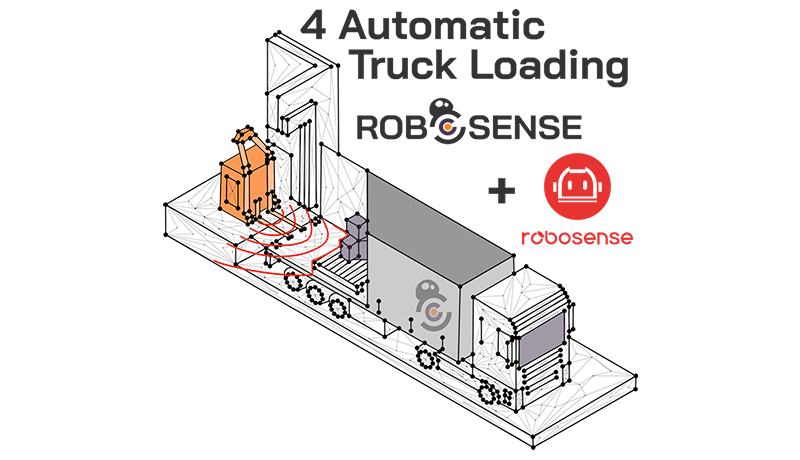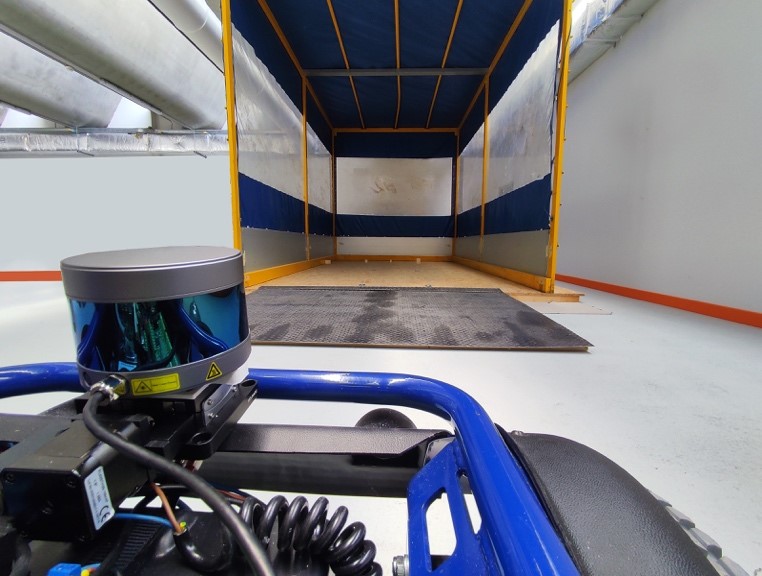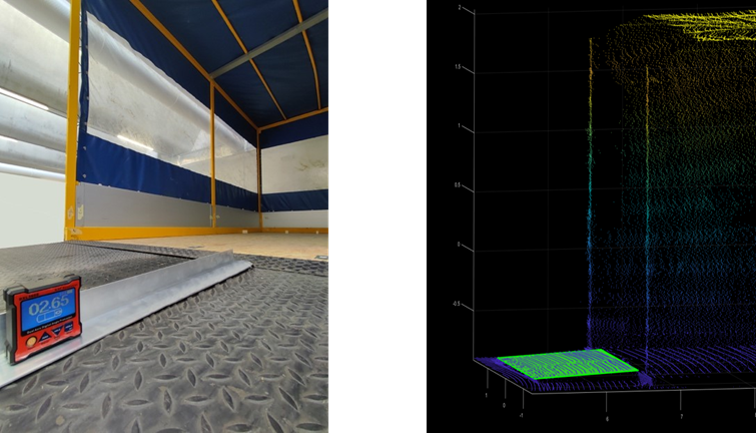

Also known as ATLS (automated truck loading system), an automatic truck loading and unloading system consists of the autonomous insertion and removal of pallets into/from a truck using two families of solutions:
○ Moving floor conveyors, slip chains, or trailer kate systems.
○ Autonomous Guided Vehicles, also known as AGVs.
ATLS offers many benefits such as: increasing a robot working capacity throughout the day; stocking area optimization; proper goods handling; labor force optimization: docks are among the busiest areas, automatic truck loading reduces the number of workers required in a zone, allowing them to be assigned to other tasks; operator safety: goods handling is one of the most critical and high-risk operations in the warehouse; lowering operating costs thus ensuring a fast Return on Investment (ROI).
The first family of solutions requires trailer modifications, and the load must be prepared at the docking station before the truck arrives, then the loading phase is very fast: in the order of a few minutes. This solution is viable for customers that have high-volume logistics with a small fleet of dedicated trailers.
The second is much more flexible and can be applied to a broader range of warehouse configurations. This solution can benefit from the system developed by Robosense Italy Srl, a leading Italian mechatronics and industrial robotics company, in collaboration with RoboSense, a Chinese smart LiDAR sensor system provider.
AGV based ATLS is usually performed within the following steps:
1. The truck, with its doors already open, backs up to align itself with the loading dock. Once it’s arrived at the limit, the dock door opens.
2. The AGV is equipped with a measurement system able to acquire the internal truck shape to:
a) estimate the loading volume and its compatibility with the dimensions of the pallet;
b) verify that no obstacle interferes with truck loading.
3. The AGV enters the trailer to unload the pallets. It can be equipped with a dual lift fork that enables to load the entire width of the trailer at each travel.
4. In a matter of 10 minutes, the goods loading and/or unloading process has been carried out successfully, without accidents, and with minimum staff intervention.
Current technological solutions
Perception technologies that can be applied for AGV truck loading/unloading consist of Time of Flight (ToF) cameras or Light Detection and Ranging (LiDAR) sensors applied onboard of a vehicle or in the docking station. Unfortunately, both measurement systems exhibit some limitations:
○ ToF cameras have a limited measuring range and field of view that prevent good performances in estimating the truck misalignment with respect to the docking station;
○ ToF cameras have a limited measuring range and field of view that require to apply Simultaneous Location And Mapping (SLAM) solutions that can suffer from unexpected outliers and drift in the internal truck shape estimation;
○ ToF cameras suffer from multipath which limits the accuracy in measuring planes aligned with the camera optical axis and thus the accuracy in ramp angle estimation;
○ Traditional LiDAR Sensors have a limited angular resolution that limits the ability to detect small objects at the bottom of the truck.
Solution proposed by Robosense Italy Srl:
Joining the RoboSense LiDAR technology with the Robosense Italy Srl mechatronics competence, starting from the RS-LiDAR-16 model, we have developed a scanning solution (Fig.1) able to improve the nominal vertical resolution from 2° to 0.1°.

Figure 1- Hardware solution developed to increase the vertical resolution of the LiDAR
Specifically, our hw - sw solution can:
1.Detect also little objects inside the truck.
2.Measure with high accuracy the available volume.
3.Measure the misalignment between the truck and the warehouse.
4.Measure and thus verify that the ramp inclination is compatible with the AGV kinematics.
It is important to highlight that, measuring the misalignment between the truck and the warehouse, we offer a great flexibility as far as the truck maneuver to perfectly align the truck with the docking station can be avoided. Furthermore, measuring the ramp inclination allows to check both forks and vehicle interference, if any, before entering into the truck, Fig. 2 and Fig. 3.

Figure 2 – Real measurement of the ramp inclination Figure 3 – In green the fitted plane of the ramp
System Performances
System calibration achieved the following metrological performances (*):
○ Minimum object detection: Surface area of 10cm2 up to 20 m distance.
○ Accuracy in truck misalignment estimation: ±0.5°
○ Accuracy in ramp estimation: ±0.5°
○ Accuracy in estimating the shape of the trailer in the three directions X,Y,Z: ±1 cm
(*): to be verified in the specific customer site conditions.
About Robosense Italy Srl (https://www.robosense.it):

Robosense Italy Srl is a separate entity from RoboSense LiDAR, which is a highly qualified and dynamic Italian company in the field of mechatronics and industrial robotics.
It was founded in 2012. Specific skills comprise mobile robotics (AGV localization and control in poorly structured warehouses), 3D vision (object pose detection and multi-camera system for shape reconstruction), and Mixed Reality (applications for human-robot/machine interaction). Robosense Italy Srl can serve its customers by a) providing consultancy for innovation; b) developing custom technologies originated from the research field as OEM components.
About RoboSense (www.robosense.ai):

RoboSense (Suteng Innovation Technology Co., Ltd.) is a world leading provider of Smart LiDAR Sensor Systems. It incorporates LiDAR sensors, AI algorithms and IC chipsets that transform conventional 3D LiDAR sensors to full data analysis and comprehension systems. The company's mission is to produce outstanding hardware and artificial intelligence capabilities to provide smart solutions that enable robots (including vehicles) to have perception capability superior to humans. Founded in 2014, RoboSense is headquartered in Shenzhen and has branch offices in Beijing, Shanghai, Suzhou, San Jose, Stuttgart and Karlsruhe. By the end of 2020, RoboSense had more than 600 patent applications.